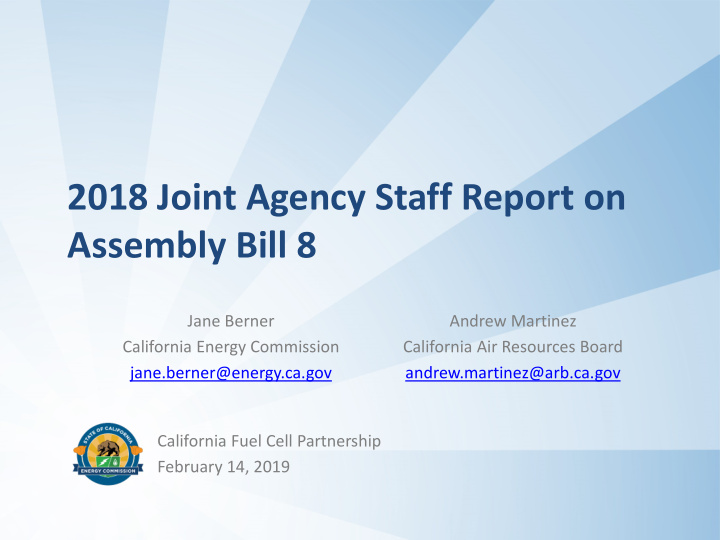



2018 Joint Agency Staff Report on Assembly Bill 8 Jane Berner Andrew Martinez California Energy Commission California Air Resources Board jane.berner@energy.ca.gov andrew.martinez@arb.ca.gov California Fuel Cell Partnership February 14, 2019
Alternative and Renewable Fuel and Vehicle Technology Program Assembly Bill 8 (2013) extended the ARFVTP through January 1, 2024 to: “… develop and deploy innovative technologies that transform California’s fuel and vehicle types to help attain the state’s climate change policies.” (Health and Safety Code Section 44272(a)) Directs Energy Commission to allocate $20 million annually to hydrogen refueling station development to establish at least 100 stations 2
AB 8 Reporting Requirements The “Annual Evaluation” prepared The “Joint Report” prepared by by the California Air Resources the Energy Commission and CARB Board (CARB) each summer each winter https://www.arb.ca.gov/msprog/zevprog/ https://www.energy.ca.gov/2018publications ab8/ab8_report_2018_print.pdf /CEC-600-2018-008/CEC-600-2018-008.pdf 3
Hydrogen Refueling Infrastructure Status Update Progress through end of 2018: • 39 stations open to the public – 38 ARFVTP-funded – 1 privately-funded • 26 stations in development • Funded network will provide 17,000 kilograms per day of nameplate capacity 4
Fuel Cell Electric Vehicle Deployment 5,658 FCEVs sold or leased as of December 1, 2018 5 https://cafcp.org/by_the_numbers
Renewable Hydrogen Production • Two new renewable hydrogen production facilities dedicated to transportation funded by GFO-17-602 • Moreno Valley – StratosFuel • Kings County – H2B2 USA 6
Low Carbon Fuel Standard (LCFS) California Air Resources Board • Updated LCFS regulation introduces Hydrogen Refueling Infrastructure (HRI) credits • Hydrogen station owners may earn credits for dispensed hydrogen and remaining station capacity • The 2018 Joint Report outlines the HRI application process and provides sample analyses of potential credit revenue • Potential benefits: – More certain return on investment in hydrogen stations – Attracts more private investment – Accelerates the rate of station development 7
Daily Average Hydrogen Dispensing by Region, 2015 - 2018 8
Station Utilization by Region 2015-2018 9
Average Time Required to Permit and Construct Stations 10 Note: As explained in the Joint Report, not every funded station is included in this figure.
Projected FCEVs and Needed Capacity by Region by 2024 Additional Needed 80% of Nameplate Capacity for Funded Projected Capacity Projected Capacity FCEVs by Needed by Demand by Region (kg/day) 2024 2024 (kg/day) 2024 (kg/day) Greater Los 6,400 23,400 16,400 10,000 Angeles Area San Francisco 5,100 13,100 9,200 4,100 Bay Area San Diego 500 2,900 2,000 1,500 Area Sacramento 900 3,200 2,200 1,300 Area 11
Self-Sufficiency Evaluation Survey Responses on Hypothetical Profitable Stations 12
2018 End of Year Summary • $120 million in ARFVTP funds allocated to hydrogen stations • 64 stations funded • Public funding remains necessary to achieve the 100-station goal, as well as the 200-station goal of Governor’s Executive Order B-48-18 • CARB and the Energy Commission continue to evaluate station self-sufficiency • Hydrogen Draft Solicitation Concepts, released in January 2019, reflect strategies to reduce the time and cost to build stations Available at: https://www.energy.ca.gov/contracts/transportation.html 13
Recommend
More recommend